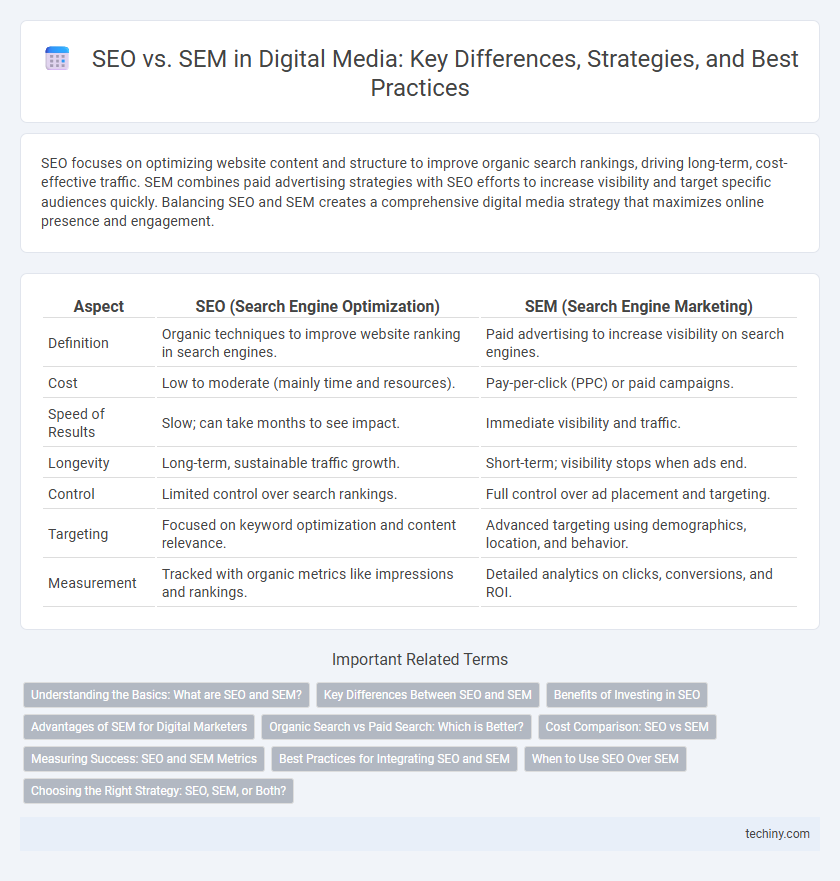SEO focuses on optimizing website content and structure to improve organic search rankings, driving long-term, cost-effective traffic. SEM combines paid advertising strategies with SEO efforts to increase visibility and target specific audiences quickly. Balancing SEO and SEM creates a comprehensive digital media strategy that maximizes online presence and engagement.
Table of Comparison
| Aspect | SEO (Search Engine Optimization) | SEM (Search Engine Marketing) |
|---|---|---|
| Definition | Organic techniques to improve website ranking in search engines. | Paid advertising to increase visibility on search engines. |
| Cost | Low to moderate (mainly time and resources). | Pay-per-click (PPC) or paid campaigns. |
| Speed of Results | Slow; can take months to see impact. | Immediate visibility and traffic. |
| Longevity | Long-term, sustainable traffic growth. | Short-term; visibility stops when ads end. |
| Control | Limited control over search rankings. | Full control over ad placement and targeting. |
| Targeting | Focused on keyword optimization and content relevance. | Advanced targeting using demographics, location, and behavior. |
| Measurement | Tracked with organic metrics like impressions and rankings. | Detailed analytics on clicks, conversions, and ROI. |
Understanding the Basics: What are SEO and SEM?
SEO (Search Engine Optimization) involves optimizing website content and structure to improve organic search rankings on engines like Google, enhancing visibility and driving free, targeted traffic. SEM (Search Engine Marketing) includes paid advertising strategies such as Google Ads to promote websites through sponsored listings, offering immediate exposure and measurable ROI. Both SEO and SEM are essential for digital marketing success, with SEO focusing on long-term growth and SEM delivering quick, targeted results.
Key Differences Between SEO and SEM
SEO (Search Engine Optimization) focuses on improving organic search rankings through keyword optimization, quality content creation, and technical website enhancements to increase visibility without direct payment. SEM (Search Engine Marketing) involves paid advertising strategies such as pay-per-click (PPC) campaigns to drive immediate traffic and generate leads through targeted ads on search engines. The key difference lies in SEO's long-term, cost-effective approach to build credibility and SEM's short-term, budget-dependent method for rapid visibility and traffic acquisition.
Benefits of Investing in SEO
Investing in SEO enhances organic search visibility, driving sustainable, long-term traffic without continuous ad spend. SEO builds brand authority and credibility by ranking higher in search engine results pages (SERPs), increasing user trust. Optimized content targeting relevant keywords improves user experience and conversion rates, maximizing return on investment (ROI).
Advantages of SEM for Digital Marketers
SEM offers digital marketers immediate visibility through paid search ads, driving targeted traffic faster than SEO's organic methods. It provides precise audience segmentation and budget control, allowing for efficient campaigns and measurable ROI. By leveraging real-time data and analytics, SEM enables rapid optimization and adaptability to market trends.
Organic Search vs Paid Search: Which is Better?
Organic search focuses on optimizing website content through SEO techniques like keyword research, quality backlinks, and user experience to improve visibility in unpaid search results, generating long-term, cost-effective traffic. Paid search, or SEM, utilizes paid advertisements such as PPC campaigns to drive immediate traffic by targeting specific keywords and demographics, offering quicker results but at ongoing costs. Businesses seeking sustainable growth often prioritize organic search for lasting authority, while those needing fast conversions leverage paid search for rapid market penetration.
Cost Comparison: SEO vs SEM
SEO typically involves lower upfront costs since it focuses on organic traffic growth through keyword optimization and content creation, while SEM requires continuous investment in paid advertising campaigns like PPC. Over time, SEO offers a more cost-effective strategy as it builds sustainable search visibility, whereas SEM delivers immediate results but can become expensive due to bidding competition and click costs. Businesses often allocate budgets differently, prioritizing SEM for quick lead generation and SEO for long-term organic growth.
Measuring Success: SEO and SEM Metrics
Measuring success in SEO revolves around organic traffic growth, keyword rankings, and click-through rates, which indicate the effectiveness of content optimization and user engagement. SEM metrics focus on cost-per-click (CPC), conversion rates, and return on ad spend (ROAS) to evaluate paid campaign efficiency and budget utilization. Analyzing these distinct but complementary metrics ensures a comprehensive understanding of digital marketing performance.
Best Practices for Integrating SEO and SEM
Combining SEO and SEM amplifies digital visibility by leveraging organic ranking and paid advertising strategies simultaneously. Optimize keyword research to identify high-converting terms for both PPC campaigns and on-page SEO, ensuring consistent messaging and maximizing click-through rates. Monitor performance metrics across platforms like Google Analytics and Google Ads to refine targeting, budget allocation, and content optimization for improved ROI.
When to Use SEO Over SEM
SEO is more effective than SEM when aiming for long-term organic growth and sustainable website traffic without ongoing advertising costs. It is ideal for businesses with limited marketing budgets looking to build brand authority and improve search engine rankings over time. Choosing SEO over SEM is beneficial when targeting highly relevant keywords with competitive content that can evolve to attract consistent, quality leads.
Choosing the Right Strategy: SEO, SEM, or Both?
Choosing the right strategy between SEO and SEM depends on business goals, budget, and timeline. SEO offers organic growth through optimized content and keyword research, enhancing long-term visibility, while SEM delivers immediate traffic through paid advertising campaigns such as Google Ads. Combining both strategies maximizes reach by leveraging SEO's sustainable presence alongside SEM's targeted, fast results, ideal for competitive digital media markets.
SEO vs SEM Infographic

 techiny.com
techiny.com